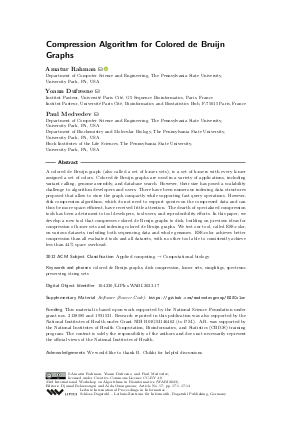@InProceedings{rahman_et_al:LIPIcs.WABI.2023.17,
author = {Rahman, Amatur and Dufresne, Yoann and Medvedev, Paul},
title = {{Compression Algorithm for Colored de Bruijn Graphs}},
booktitle = {23rd International Workshop on Algorithms in Bioinformatics (WABI 2023)},
pages = {17:1--17:14},
series = {Leibniz International Proceedings in Informatics (LIPIcs)},
ISBN = {978-3-95977-294-5},
ISSN = {1868-8969},
year = {2023},
volume = {273},
editor = {Belazzougui, Djamal and Ouangraoua, A\"{i}da},
publisher = {Schloss Dagstuhl -- Leibniz-Zentrum f{\"u}r Informatik},
address = {Dagstuhl, Germany},
URL = {https://drops.dagstuhl.de/entities/document/10.4230/LIPIcs.WABI.2023.17},
URN = {urn:nbn:de:0030-drops-186434},
doi = {10.4230/LIPIcs.WABI.2023.17},
annote = {Keywords: colored de Bruijn graphs, disk compression, k-mer sets, simplitigs, spectrum-preserving string sets}
}

 Creative Commons Attribution 4.0 International license
Creative Commons Attribution 4.0 International license




























